Breaking Gold
The Gold Thief of the Arahura Dredge
Leo Morland’s nefarious crime, which made him one of New Zealand’s last great gold thieves, is a tale almost lost to time. We’ll bring our gaze to the details of his scheme, his time on trial, and how he almost got away with one of the largest gold thefts in New Zealand history.
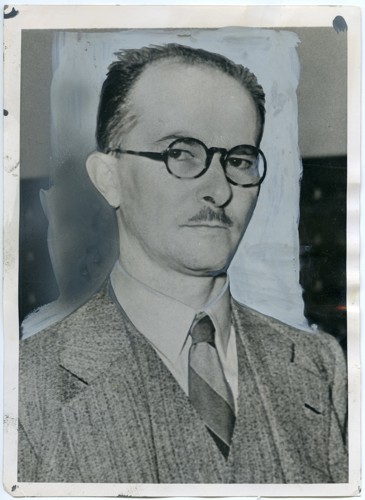
#020267 Moreland Leo
Born in Sydney, Australia, as Leo Edward Morland; he dropped out of school to eventually become a metallurgist for 14 years and married for a time before separating. After unsuccessfully attempting to run his own assaying business and making ends meet from any odd job available, he found some relief in Papua New Guinea with a gold company. This gave him a modest but stable income for a year and a half. Until the company closed.
With no opportunities for him in Australia, he left for New Zealand. There, in Jan 25th, 1940, he found employment at the Arahura Dredging Company on a big dredge near Hokitika, where he gained sole control overseeing the gold-bearing excavations. And it’s here where Morland’s plan went into motion.
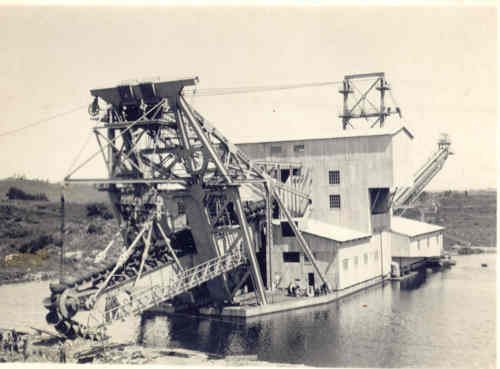
#14623 Arahura Dredge34
Leo Morland’s time in the company made him well-liked by those there. He was noted to be well-read with a polite nature, though was also a quiet man who stayed kindly in the background, smoking on a pipe. A notable dip in gold volumes occurred unexplainably while he was on the dredge in the Arahura Valley, yet it went unquestioned. Unbeknownst to anyone it was Leo that was stealing the company’s gold. Over the nine months he worked on the dredge he managed to steal 3,650 ounces – over $10,000,000 in today’s value.
Although staying in a hotel room, Morland also rented a hut roughly a mile away where he had his metallurgy equipment housed and even installed a new and very large stove. When questioned by his landlord on the intense heat within the hut, Leo replied he was “feeling the cold”. In truth, the hut had been converted into a makeshift furnace room where he smelted the accumulated stolen ore of 3,650 ounces into gold bars.
In October, he quit the company, telling them of a better business opportunity in Canada – which, in hindsight, wasn’t entirely a lie. He left for Vancouver, Canada, that same year, passing both New Zealand and Canadian customs without a slip. They examined his belongings but saw only personal items, such as books and scientific equipment. But hidden away in his book crates and instruments were false bottoms he had crafted himself, and in them was Morland’s golden treasure, 124 pure bars of gold.
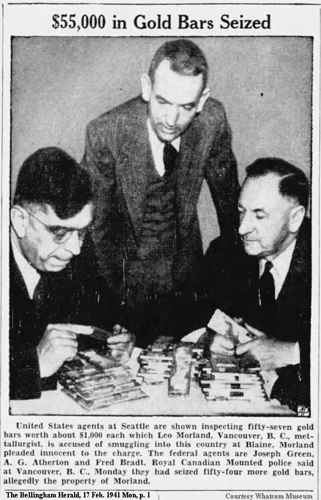
$55,000 in Gold Bars Seized, Page 1,The Bellingham Herald, 17 Feb, 1941 Mon. Courtesy of Whatcom Museum.
Morland’s first six bars were sold to an unknown buyer, profiting him $1,500 (roughly worth 27,000 Canadian today). He used the money to buy himself many luxuries, one being a car which he would use to hide his gold later.
Leo joined forces with a jeweler named Martin Jacoby, who wanted to refine the gold so its value would increase. At some point, the duo dined with a man from Seattle who, after much bartering, offered to purchase roughly $50,000 worth of gold ($10,000,000 today). They agreed, and the two set off to meet their buyer.
Morland was so close to achieving his goal, the fruits of his labor so nearly ripe. But alas, this wasn’t meant to be; just when he crossed into American borders, he was stopped by guards in Blaine. An unknown informer had tipped authorities off, though who this was has never been clear.
Some sources say it was the Seattle man, other says it was a “foreign government”. Either way, Leo Morland was caught, and soon the stolen gold was found, stowed between the boot and rear seat of his car. The rest (64 bars) was hidden back in the room of his hotel. All was confiscated. Jacoby, who had traveled ahead of Morland via bus, was also arrested. He was sentenced to 3 years of hard labor.
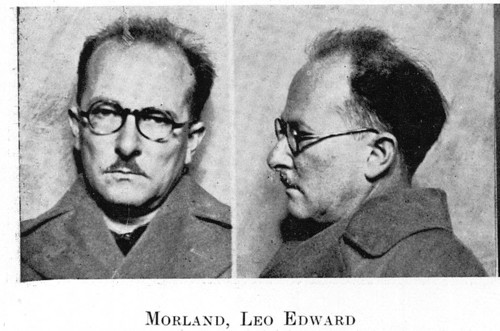
Leo Edward Morland, Page 61, Police Gazette, 1943, Source: PapersPast
Leo Morland was charged 14 months imprisonment in the federal penitentiary on McNeil Island, Washington – home also to the serial killers Robert Franklin Stroud, better known by his later title as “The Birdman of Alcatraz”, and the late Charles Manson.
Word spread far of the smuggled gold, and soon the question as to who legally owned the gold arose. The Canadian government wanted the bars to be held in Seattle and returned, but the Americans wouldn’t agree. The Arahura Dredging Company, having learned of the crime and connecting the dots, wasted no time chiming into the dispute. Leo Morland even added his voice, maintaining his innocence and claimed that the gold belonged to him.
In the end, the company won the battle after testing proved the gold came from New Zealand and Arahura soils. Though the bars never returned, the company was compensated handsomely. At the end of his sentence, Leo was deported back to New Zealand and rearrested. Difficult times caused delays in his trial, so by the time it was set he had spent nearly two years in Canadian, American, and New Zealand custody.
He was tried in Christchurch’s Supreme Court on May 19th, 1943. He maintained his story of innocence and that the gold was earned through legitimate means. Presented to the court was a tale of his struggles and the hardships of his life. He was a small, pale, slow-speaking man who barely made $10 a week in his life.
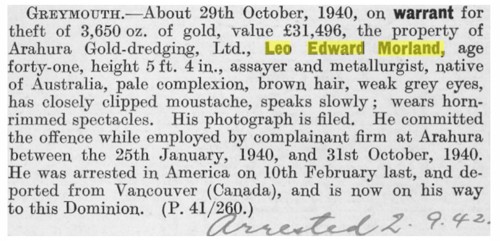
Persons Wanted, Warrant Issued, Page 679, Leo Edward Morland, NZ Police Gazzette, Vol LXVII, Issue 33, 19 August 1942
Leo Morland supposedly died in Addington Prison due to mercury poisoning, a result from him inhaling the toxic fumes of the gold he smelted.
